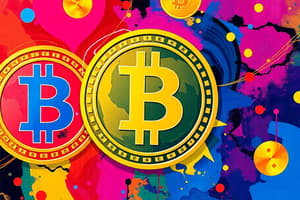Podcast
Questions and Answers
Given the nuances of tokenomics within decentralized finance (DeFi), how might a project's token distribution strategy that heavily favors early investors and advisors, while neglecting community allocation, impact its long-term sustainability and decentralization ethos?
Given the nuances of tokenomics within decentralized finance (DeFi), how might a project's token distribution strategy that heavily favors early investors and advisors, while neglecting community allocation, impact its long-term sustainability and decentralization ethos?
- It fosters a robust, meritocratic ecosystem where experienced stakeholders guide the project's development, leading to efficient decision-making and minimized volatility.
- It enhances network security by concentrating tokens among trusted entities, thereby reducing the risk of Sybil attacks and malicious governance proposals.
- It centralizes influence, potentially stifling genuine community participation, increasing vulnerability to coordinated market manipulation, and undermining the project's resilience against external pressures. (correct)
- It mitigates regulatory scrutiny by establishing clear lines of accountability and control, ensuring compliance with evolving legal frameworks and fostering investor confidence.
Assuming a blockchain project implements a dual-token model, with one token for utility and another for governance, what are the potential emergent risks if the governance token disproportionately accrues economic value, overshadowing the utility token's role within the ecosystem?
Assuming a blockchain project implements a dual-token model, with one token for utility and another for governance, what are the potential emergent risks if the governance token disproportionately accrues economic value, overshadowing the utility token's role within the ecosystem?
- The ecosystem becomes more resilient to external shocks, as the governance token acts as a stabilizing force, absorbing volatility and protecting the utility token from market fluctuations.
- The utility token's adoption accelerates due to increased awareness and investment driven by the governance token's success, fostering a virtuous cycle of growth and innovation.
- A harmonious balance emerges, where the governance token's value reflects the overall health and adoption of the utility token, incentivizing long-term alignment between stakeholders and users.
- A speculative bubble may form, diverting resources and attention away from core utility development, ultimately leading to decreased real-world adoption and an unsustainable economic model. (correct)
In an inflationary tokenomic model, how does the strategic implementation of a dynamic burn mechanism, contingent on real-time network activity and user participation, influence the trade-off between incentivizing early adoption and mitigating long-term value dilution?
In an inflationary tokenomic model, how does the strategic implementation of a dynamic burn mechanism, contingent on real-time network activity and user participation, influence the trade-off between incentivizing early adoption and mitigating long-term value dilution?
- It complicates economic modeling, introducing uncertainty and potentially deterring new users who are wary of unpredictable supply adjustments and fluctuating token values.
- It creates a self-regulating system that aligns token scarcity with network growth, dynamically adjusting the burn rate to optimize user incentives and long-term value preservation. (correct)
- It ensures a consistent token supply, fostering predictability and stability, which is crucial for attracting institutional investors and establishing clear regulatory frameworks.
- It primarily benefits early adopters who accumulate a significant portion of the token supply before the burn mechanism takes effect, exacerbating wealth inequality within the ecosystem.
Considering the complexities of regulatory classification in the cryptocurrency space, how could the ambiguous categorization of a utility token as a potential security impact its long-term viability and adoption across different jurisdictions, given the varying legal interpretations?
Considering the complexities of regulatory classification in the cryptocurrency space, how could the ambiguous categorization of a utility token as a potential security impact its long-term viability and adoption across different jurisdictions, given the varying legal interpretations?
Within the context of decentralized governance, what are the potential ramifications of a quadratic voting system, designed to empower smaller token holders, on the overall efficiency and decisiveness of protocol upgrades and parameter adjustments, especially in time-sensitive situations?
Within the context of decentralized governance, what are the potential ramifications of a quadratic voting system, designed to empower smaller token holders, on the overall efficiency and decisiveness of protocol upgrades and parameter adjustments, especially in time-sensitive situations?
How might the interplay between 'circulating supply' and 'maximum supply' influence investor perception and token valuation, considering the potential for future token releases to impact market dynamics and price stability?
How might the interplay between 'circulating supply' and 'maximum supply' influence investor perception and token valuation, considering the potential for future token releases to impact market dynamics and price stability?
Considering the nuances of vesting schedules, how does the strategic design of lockup periods for team members and early investors impact the long-run alignment of incentives and mitigate the risk of detrimental sell-offs?
Considering the nuances of vesting schedules, how does the strategic design of lockup periods for team members and early investors impact the long-run alignment of incentives and mitigate the risk of detrimental sell-offs?
Assuming a token's utility is multifaceted, encompassing governance, staking, payments, and network access, what strategies effectively prioritize these use-cases to drive adoption and bolster the token's intrinsic value?
Assuming a token's utility is multifaceted, encompassing governance, staking, payments, and network access, what strategies effectively prioritize these use-cases to drive adoption and bolster the token's intrinsic value?
In a proof-of-stake (PoS) consensus mechanism, how does the tokenomic design influence validator behavior and network security when staking rewards are dynamically adjusted according to network participation and slashing penalties?
In a proof-of-stake (PoS) consensus mechanism, how does the tokenomic design influence validator behavior and network security when staking rewards are dynamically adjusted according to network participation and slashing penalties?
When evaluating a project's tokenomics, how does an assessment of its economic model (inflationary, deflationary, or dual-token) reveal insights into its long-term sustainability, value accrual mechanisms, and adaptability to evolving market conditions?
When evaluating a project's tokenomics, how does an assessment of its economic model (inflationary, deflationary, or dual-token) reveal insights into its long-term sustainability, value accrual mechanisms, and adaptability to evolving market conditions?
Flashcards
What is Tokenomics?
What is Tokenomics?
The study of economic models behind cryptocurrency tokens, considering factors like supply, distribution, and utility.
What is a Token?
What is a Token?
A digital asset generated and managed on a blockchain, representing various assets, rights, or utility.
Circulating Supply
Circulating Supply
The number of liquid tokens available for trading on the market.
Token Burn
Token Burn
Signup and view all the flashcards
Governance
Governance
Signup and view all the flashcards
Initial Allocation
Initial Allocation
Signup and view all the flashcards
Economic model
Economic model
Signup and view all the flashcards
Vesting periods
Vesting periods
Signup and view all the flashcards
Use case (Utility)
Use case (Utility)
Signup and view all the flashcards
Incentives and rewards
Incentives and rewards
Signup and view all the flashcards
Study Notes
- Tokenomics is important for those in or interested in cryptocurrencies.
- Tokenomics concerns how digital tokens are created, maintained, and circulated within a blockchain system.
- It is similar to traditional economics and affects a digital asset's value, usefulness, and potential.
- By understanding tokenomics, one can grasp key concepts and its importance for decentralized finance's future.
What is Tokenomics?
- Tokenomics is the study of economic models behind cryptocurrency tokens/assets.
- Tokenomics considers parameters like total supply, future dilution, initial distribution, vesting durations, utility, burn mechanisms, and economic stability.
- A token's value is tied to its tokenomics where high utility, restricted supply, and high demand in a thriving ecosystem can increase its value.
- A token's value may decline if it lacks utility, has an oversupply, and is has no unique role or demand.
- Tokens with a supply cap and burn mechanisms may increase in value with a falling circulating supply if demand is constant or increasing.
- Tokens that reward holders with more tokens may face selling pressure if holders liquidate their incentives.
- Tokenomics is a blueprint for a token's possible value trajectory.
- Market sentiment, trends, laws, and tech breakthroughs influence token value.
What is a Token?
- A crypto token is a digital asset created and managed on the blockchain.
- Coins have their own blockchains, like Bitcoin (BTC) on the Bitcoin blockchain, and Ether (ETH) on Ethereum.
- Coins serve as a means of commerce, store of value, and unit of account, similar to real money for buying, selling, or storing value.
- Tokens are created using smart contracts on other blockchains, such as Ethereum/Solana.
- Tokens may represent assets, a project stake, voting rights, functionality access, or anything the issuer chooses and serve monetary purposes.
The Importance of Tokenomics
- It's always a good time to learn about tokenomics to make better investing choices.
- While Bitcoin is a peer-to-peer value transfer protocol, altcoins try to influence investors with new concepts.
- Assets vary widely, and understanding what drives them and their investment potential is important.
- Tokenomics means the architecture and framework for token distribution and operation in blockchain.
- It showcases a token's utility, demand, and value, allowing investors to assess long-term value and product relationships.
- Sometimes tokens are used only for fundraising without further use/value.
- Tokenomics can manipulate a token's scarcity/abundance, impacting its price/adoption.
- Distributing tokens to the team, investors, advisors, or a reserve impacts prices.
- Lockup periods and token issuances offer insight into market swings.
- A good token economy improves network security, incentivizes behavior, and secures project viability, while faulty tokenomics cause imbalances/manipulations.
Key components of tokenomics
- Defines how a crypto or token operates in an ecosystem and is key to understanding its utility, distribution, and long-term value.
Token Supply
- The crypto’s supply is influenced by protocol rules and external factors.
- Maximum supply: Represents all tokens that will ever exist.
- New projects typically lock most supply initially, releasing it over time.
- Circulating Supply: Refers to the tradable liquid tokens on the market.
- Some projects create a set number of tokens used for fundraising, rewards, and marketing, with the remaining tokens given to players.
- If the total number of tokens is fixed, it simplifies modeling by requiring only demand assessment.
- Inflationary Supply: Miners/validators are rewarded with new tokens for validating new blocks.
- The same principles may be included in a token smart contract.
- Depending on frequency/conditions of rewards, predicting supply at a specific time may be impossible.
- When assessing project token price, consider maximum supply because only looking at circulating supply and market capitalization can be misleading.
Token Distribution
- Crypto tokens are used as a unit of account, which transforms fundraising for startups/DAOs.
- Issuing a token can provide liquidity and utility to investors while increasing transparency.
- Initial token allocation refers to how tokens are distributed during the initial coin offering (ICO), pre-sale, or airdrop and can include allocations for developers, investors, advisors, and the community.
- Distribution mechanisms include ICOs, Security Token Offerings (STOs), and Initial Exchange Offerings (IEOs).
- Vesting periods are timelines set to unlock tokens for team members/investors to prevent sell-offs and promote long-term commitment.
Use Case (Utility)
- Tokens can be designed for governance, staking, payments, or network access, while playing a role in the platform/ecosystem, like incentivizing users or powering transactions.
Governance
- Tokens allow holders to participate in decision-making via voting on platform proposals.
- Voting power is proportional to the number of tokens held.
Incentives and Rewards
- Tokens may offer staking rewards, where holders lock up tokens for interest/additional tokens.
- Miners/validators earn tokens by securing he network and confirming transactions.
- Users can earn tokens by contributing to the ecosystem or providing liquidity.
Burn Mechanism
- Token burning is permanently removing tokens from circulation to increase scarcity and token value over time.
- The burn frequency/amount can be pre-determined or based on network activity.
Economic Model
- Inflationary models: New tokens are regularly issued, which may dilute value over time but support network growth.
- Deflationary model: The supply decreases over time, which can create scarcity and potentially increase value.
- Dual-token model: An ecosystem may use tokens for utility and others for governance/rewards.
Liquidity
- Market access shows how easily tokens can be traded on exchanges.
- Decentralized finance (DeFi) platforms often require liquidity pools, where users provide tokens for trading and earn fees/rewards.
Legal and Regulatory Compliance
- Regulatory classification: How the token is classified in different jurisdictions (security, utility token, etc.) and how it complies with the law.
- Smart contracts and token distribution mechanisms undergo third-party audits for compliance.
- These components shape a cryptocurrency project's value, functionality, and success.
Studying That Suits You
Use AI to generate personalized quizzes and flashcards to suit your learning preferences.




